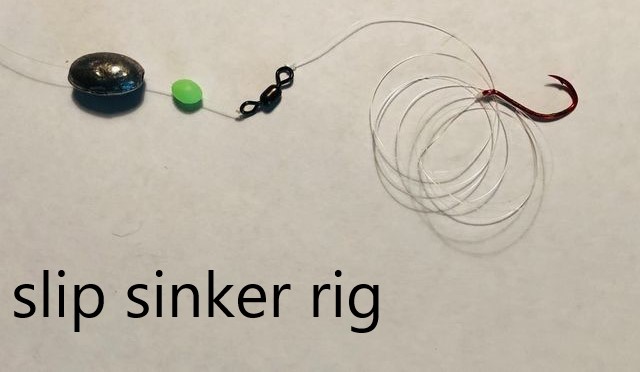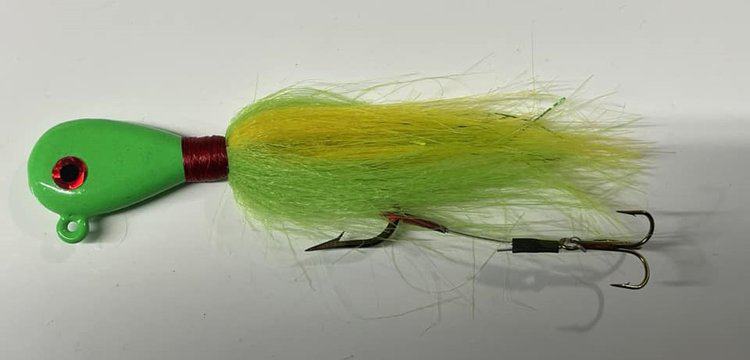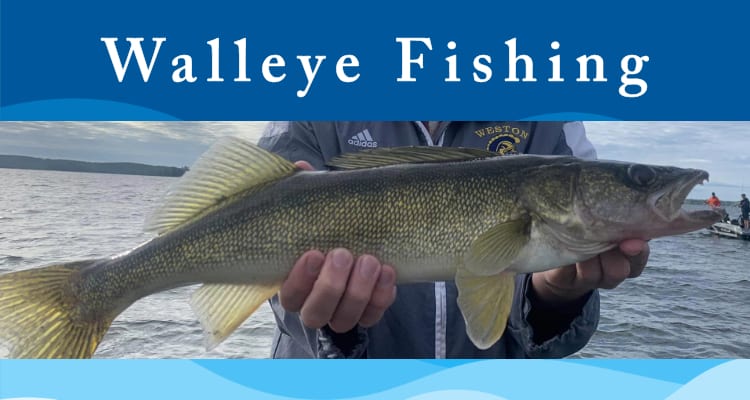Walleye, belonging to the perch family, are a popular freshwater fish known for their unique appearance and behavior. Their name comes from their distinctive pearlescent eyes, a result of the tapetum lucidum, a reflective layer of pigment that enhances their vision in low-light conditions. This adaptation is particularly useful for feeding at night or in murky waters, where their primary diet consists of smaller fish, though they also consume insects during summer.
Catching walleye can be an enjoyable and rewarding experience. These fish are well-regarded by anglers for their fighting spirit and the skill required to catch them. The challenge lies in understanding their behavior and habitat preferences.
This guide will cover various aspects of walleye fishing, including the ideal fishing setup, the best baits and lures, effective fishing techniques, the optimal times for fishing, preferred habitats, and useful tips for beginners. Whether you’re an experienced angler or new to fishing, this guide aims to provide you with comprehensive insights into catching this fascinating species.
Walleye Fishing Setup
The most common tackle for catching walleye includes a medium-light to medium-action rod, typically between 6 and 7 feet in length. This size offers a good balance of sensitivity and power, essential for feeling the bite of a walleye and then effectively setting the hook. Pair this rod with a spinning reel for ease of use and better control, especially beneficial for beginners. The reel should be spooled with 6 to 10-pound test monofilament or fluorocarbon line. These lines are thin and less visible underwater, making them ideal for the clear waters where walleye are often found.
The best overall fishing setup for walleye often involves a jig and live bait combination. A jig weighing between 1/8 to 1/4 ounces is typically most effective, as it allows for a natural, slow descent and a subtle presentation, which is key for attracting walleye. Tip the jig with live bait such as minnows, leeches, or nightcrawlers for added attraction. This setup is versatile and can be used in a variety of water depths and conditions, making it a go-to choice for many anglers.
Regarding the best rig for walleye, the slip-sinker rig, also known as the Lindy Rig, is highly favored. This setup includes a sliding weight, a swivel to prevent line twist, a leader (usually 2 to 4 feet long), and a hook. For the hook, use a size 4 to 6 for live bait. The slip-sinker rig is designed to move smoothly over rocky bottoms while keeping the bait at a natural, appealing depth for walleye. It’s particularly effective to catch fish in deeper waters or along the bottom, where walleyes often feed.

Best Bait For Walleye
Walleye are predominantly piscivorous, meaning their diet mainly consists of smaller fish. This dietary preference plays a crucial role in determining the best bait for catching them.
The best live baits for walleye are minnows, leeches, and nightcrawlers. Minnows are particularly effective because they mimic the primary food source of walleye. Use a jig head or a live bait rig to present the minnow in a natural, enticing manner. Leeches work exceptionally well in warmer waters, especially during the summer months. They can be rigged on a simple slip-sinker setup, allowing them to move naturally in the water. Nightcrawlers are another top choice, especially when used with a spinner rig or a bottom bouncer setup, as they create an appealing action and scent trail in the water.
When it comes to artificial baits, there are several walleye fishing lures that stand out. Crankbaits are highly effective, especially those that mimic small fish. They can be trolled or cast and retrieved, making them versatile for various water depths and conditions. Jigs are another indispensable lure for walleye fishing. Tip them with a plastic grub or a piece of live bait to increase their attractiveness. When using jigs, a slow, steady retrieve or a lift-and-drop technique can be very effective. Soft plastic lures, like swimbaits or worms, are also successful when targeting walleye. They’re best used with a jig head and can be retrieved with a steady motion or twitched to mimic injured prey.
Spinnerbaits and spoons are also great for catching walleye. These lures create flash and vibration in the water, drawing attention from walleyes. Use a steady retrieval or a stop-and-go technique to mimic a wounded baitfish, making the lure irresistible to predatory walleye.

Walleye Fishing Techniques
Here are some of the most common and effective techniques for catching walleye, along with explanations of their setups and ideal conditions for use.
Jigging
Jigging is the most popular technique to catch walleye. The setup involves a jig head paired with live bait (like minnows or nightcrawlers) or soft plastics. The weight of the jig head can vary depending on water depth and current, typically ranging from 1/8 to 1/2 ounce. This technique is most effective in a variety of conditions, from shallow to deep waters. The key is to let the jig touch the bottom and then use a series of lifts and drops to mimic a wounded baitfish. Jigging is particularly effective in colder water temperatures when walleye are less active and are more likely to go for a slowly moving target.
Trolling
Trolling is a productive way to cover a lot of water and locate actively feeding walleye. This technique involves dragging lures, such as crankbaits or spinner rigs, behind a slowly moving boat. The setup usually consists of a medium-action rod with a baitcasting or spinning reel, spooled with 10 to 20-pound test line. Planer boards can be used to spread out the lures and cover a wider area. Trolling is most effective in open water, especially during the summer months when walleye are dispersed and can be found at various depths.
Live Bait Rigging
Live bait rigging, often with a slip-sinker setup, is a classic and highly effective method for walleye. This technique typically uses a live minnow, leech, or nightcrawler on a hook, connected to a leader line (2 to 4 feet long), with a sliding weight above the swivel on the main line. The key is to present the bait as naturally as possible, keeping it just off the bottom. This technique is particularly effective in clear water conditions and when walleye are a bit finicky. It’s excellent for fishing along drop-offs and submerged structures.
Casting
Casting is a great technique when fishing from shore or in shallower waters. This method involves casting out lures like crankbaits, jigs, or spinners, and then retrieving them in a manner that mimics live prey. The setup for casting includes a medium-action rod with a spinning or baitcasting reel, loaded with 6 to 10-pound test line. The best times for casting for walleye are during low light conditions, such as early morning or late evening, when walleye move into shallower waters to feed.
Bottom Bouncing
Bottom bouncing is a technique tailored for fishing in deeper waters, particularly along the bottom where walleye often feed. This setup involves a bottom bouncer weight attached to the main line, with a 2 to 3-foot long leader tied to a lure or live bait rig. The weight keeps the bait near the bottom, and the boat’s movement imparts action to the bait. This technique is especially effective during the summer and fall when walleye are holding at specific depths along drop-offs or near underwater structures.
Best Time To Catch Walleye
Catching walleye successfully depends significantly on understanding their behavior at different times. Here’s a detailed overview:
- When do walleye spawn: Walleye typically spawn in the spring when water temperatures reach around 45-50°F.
- Best time of day to catch walleye: Early morning and late evening are prime times, as walleye feed actively during low light conditions.
- Best time of year to catch walleye: Fall is often considered the best season, as walleye feed aggressively to prepare for winter, making them more likely to bite.
Spring
In spring, post-spawn, walleye move to areas with abundant food. The best time to catch them is in the late afternoon and evening as they start feeding actively. Jigging and live bait rigging near spawning grounds can be highly effective. As the water warms up, walleye become more active, making this a favorable season for fishing.
Summer
During the hot summer months, walleye typically feed during cooler periods of the day, such as early morning or just before sunset. Trolling with crankbaits or using live bait rigs in deeper waters can be very successful. Walleye tend to seek deeper, cooler waters during the day, so focusing on deeper regions is key.
Fall
Fall is an excellent time for walleye fishing. The fish feed aggressively in preparation for winter. The best times are early morning and late evening. Trolling and jigging in shallower waters can yield good results, as walleye move closer to shore to feed.
Winter
In winter, walleye slow down but can still be caught, especially through ice fishing. Midday, when the water is slightly warmer, is the best time. Using jigs and spoons near the bottom where the walleye stay during colder temperatures is the most effective technique.
Night
Night fishing for walleye can be highly productive. They feed actively after dark, especially in shallower waters. Using luminous jigs or crankbaits that make noise or vibrate can attract walleye. Focus on areas with structure or where baitfish are likely to be found. Slow retrieval of lures is key, as walleye are more likely to go after a target that doesn’t require a fast chase.
Where To Find Walleye
Walleye are most commonly found in freshwater bodies such as lakes, rivers, and large ponds. They prefer water depths that vary with the season, ranging from shallow waters (5-10 feet) during spawning in the spring, to deeper waters (15-30 feet or more) in the summer and winter.
Fish finders are invaluable tools for locating walleye, especially in deeper waters, as they help identify underwater structures, depth changes, and the presence of fish.
Lakes
Lakes are prime habitats for walleye, especially those with a mix of deep and shallow areas, and abundant structures like weed beds, rocky points, and drop-offs. In lakes, trolling is an effective technique. Use crankbaits or spinner rigs at varying depths, adjusting according to the season and water temperature. During the summer, focus on deeper waters during the day, moving to shallower areas during low light conditions.
Rivers
Rivers offer dynamic environments for walleye, with current seams, eddies, and structures like sunken logs or boulders. Jigging is particularly effective in rivers. Use a heavy enough jig to maintain contact with the bottom despite the current. Live bait, like minnows or nightcrawlers, can enhance the lure’s attractiveness. Focus on areas with slower currents, near structures that provide breaks in the flow, where walleye typically hunt.
Shore Fishing
Shore fishing for walleye is quite common, particularly in the early morning and late evening. Casting crankbaits, jigs, or spinner rigs from the shore can be successful. Target areas where there are drop-offs close to shore, or structures like docks, weed beds, or rocky points. In spring and fall, walleyes come closer to the shore to feed, making them more accessible to shore anglers.
Large Ponds
In large ponds, walleye can often be found around structures like submerged trees, weed lines, and drop-offs. A simple jig and live bait setup can be very effective in these environments. Cast near the structures or along the edges of weed beds, and use a slow, steady retrieve to entice the walleye.
Tips To Catch Walleye For Beginners
- For beginners, a medium-action spinning rod and reel combo is ideal. It’s versatile and easier to handle than other setups.
- Spool the reel with 6-10 pound test monofilament line, which offers a good balance of strength and sensitivity.
- A simple jig head (1/8 to 1/4 ounce) paired with a soft plastic body or live bait is an effective and easy-to-use setup.
- Live minnows are the best walleye baits for beginners. They are appealing to walleye and easy to rig. Leeches and nightcrawlers are also good options.
- Thread the hook through the lip or back of the minnow for a natural presentation. For worms or leeches, hook them once or twice, leaving a portion dangling for natural movement.
- A slip bobber setup allows you to easily adjust the depth at which you’re fishing, which is crucial as walleye can be found at varying depths.
- Walleye often hang around areas with structure like rocks, fallen trees, or weed edges, as well as areas where the depth changes rapidly. Focus to catch walleye near structure and depth changes.
- If fishing in a river or stream, look for areas with slower currents, such as behind large rocks or downed trees, as walleye often rest in these spots.
- Early morning or late evening, when the light is low, are typically the best times to catch walleye, as they are more active during these periods.
- Walleye fishing can require patience. If one spot or technique isn’t working, try another spot or switch up your bait or lure.
- If fishing from a boat, a fish finder can be incredibly helpful in locating walleye, especially in deeper or larger bodies of water.
Best Walleye Fishing Gear And Tools
The best fishing gear for walleye includes a specific selection of rods, reels, lines, and optional electronics like fish finders, each with attributes tailored to the unique challenges of walleye fishing.
Fishing Rod
For walleye fishing, a medium-light to medium-action spinning rod is ideal. Lengths between 6.5 to 7 feet offer a good balance of sensitivity and casting ability. The rod should have enough backbone to set the hook firmly but also enough flexibility to handle the fight of a walleye without pulling the hook. Graphite material is commonly used for walleye rods for their sensitivity, as they allow you to feel subtle bites and the structure of the bottom.
Fishing Line
The line choice should be 6-10 pound test monofilament or fluorocarbon for most walleye fishing situations. Fluorocarbon is virtually invisible underwater, which is an advantage in clear water conditions where walleye can be line-shy. Braided line can also be used, especially in situations requiring a more direct feel and less stretch, but it’s often paired with a fluorocarbon leader to reduce visibility. Opt for the best walleye fishing line based on the fish size and conditions.
Fishing Reel
A smooth, reliable spinning reel in the 2500 to 3000 size range pairs well with a medium-action rod for walleye fishing. The reel should have a smooth drag system to handle the strong runs of a walleye. A higher gear ratio is beneficial for quicker line retrieval, but a moderate speed reel will work well in most situations. Quality walleye reels with good line lay and smooth operation help in casting accuracy and distance.
Fish Finder
While not essential, a fish finder can be a valuable tool for locating walleye, especially when fishing in deeper waters or unfamiliar areas. Look for a fish finder with CHIRP sonar and side imaging for better target separation and a clearer view of underwater structures where walleye often congregate. Brands like Lowrance, Humminbird, and Garmin offer advanced fish finders for walleye fishing.

